Notes: When the CK&P railway was in the planning stage a station site was considered over two miles west of that eventually adopted. Troutbeck station stood in sparsely populated country, taking its name from the nearby stream. When it opened there appeared to be limited potential for local traffic, but its location next to the road to the western end of Ullswater, about four miles distant, and Patterdale might attract tourists and climbers. However a brick and tile works was a short distance south-east of the station and a swiftly-opened siding (c1867) allowed the factory to be served by rail. A livestock auction mart was established north of the station noted for its autumn sheep sales; the first cattle pen at the station opened in 1872. Both the mart and the nearby Troutbeck Hotel were shown on the 1895 OS map. Thus by the end of the nineteenth century a small hub of economic activity had developed as a result of the opening of the station.
 As originally built the station had one platform on the north side of the single-track railway. The single-storey stone building was similar to that at Penruddock and some of the other minor stations on the route. It was provided with a pitched roof; however, at the eastern end the building stepped forward with a half-hipped gable facing east. This section contained the booking office, and its design allowed the stationmaster to have a good view of the platforms – for the same reason that some railway companies provided a bay window for the office. In addition to the office, a general room and a ladies’ waiting room were found in this building. At its western end was a short lower pitched roof and beyond it the gents’ urinal. In 1869 a stationmaster’s two-storey house was under construction, an austere hipped-roof edifice tucked into the rear of the station building; until it was completed the stationmaster lived in rented property. As originally built the station had one platform on the north side of the single-track railway. The single-storey stone building was similar to that at Penruddock and some of the other minor stations on the route. It was provided with a pitched roof; however, at the eastern end the building stepped forward with a half-hipped gable facing east. This section contained the booking office, and its design allowed the stationmaster to have a good view of the platforms – for the same reason that some railway companies provided a bay window for the office. In addition to the office, a general room and a ladies’ waiting room were found in this building. At its western end was a short lower pitched roof and beyond it the gents’ urinal. In 1869 a stationmaster’s two-storey house was under construction, an austere hipped-roof edifice tucked into the rear of the station building; until it was completed the stationmaster lived in rented property.
William Richardson was the first stationmaster at Troutbeck. Owing to ‘irregularities’ he was removed from the post and his successor was John Smith, appointed in September 1868. However this man’s term at Troutbeck was also to end in disgrace as he absconded in November 1874 having mishandled the station’s accounts.
In 1874 a down loop was constructed at Troutbeck together with a platform and an enclosed timber waiting shed. This shelter (and previously the up side buildings) was used on Sunday afternoons for Sunday school and collective acts of worship, and its furniture included a harmonium.
Up trains: weekdays
August 1887 |
Destination |
Down trains: weekdays |
Destination |
7.53am |
Penrith |
6.30am ø |
Keswick |
10.18am |
Penrith |
8.58am § |
Workington |
12.18pm |
Penrith |
9.37am |
Keswick |
4.35pm |
Penrith |
10.19am |
Workington |
7.03pm |
Penrith |
2.15pm |
Workington |
- |
- |
6.19pm |
Workington |
- |
- |
8.05pm |
Workington |
Up trains: Sunday |
Destination |
Down trains: Sunday |
Destination |
10.33am |
Penrith |
7.25am |
Workington |
7.13pm |
Penrith |
6.25pm |
Workington |
Ø Goods and passenger train; punctuality not guaranteed
§ Approximate time; stops to set down through passengers on informing the guard
Considering its rural location, Troutbeck possessed extensive sidings. In part, this was to provide storage accommodation for heavy trains which had to be worked up the long climb from Threlkeld in more than one portion. They were also needed to accommodate livestock trucks for the periodic sheep sales held at the Troutbeck auction market, close to the station. The presence of the brick and tile works has already been mentioned, but other traffic handled by the sidings included timber from Ullswater estates and the Greenside Mining Company (located near Glenridding) made use of the station’s goods facilities from the 1860s until the 1930s. As at most stations, coal was received.
Since the majority of the locomotives had used a considerable amount of their water after ascending the gradient from Threlkeld, the provision of a water tank of substantial capacity at Troutbeck was a necessity.

In 1893-94 the overbridge immediately west of the station was reconstructed to accommodate the additional railway track when the line to Threlkeld was doubled.
Like many rural stations, Troutbeck was originally oil lit, but from 1903 it was lit by acetylene gas produced by a small generator in a ‘gas house’ located amid the sidings east of the up platform.
Following the closure of the brick and tile works, the sidings were removed and the down platform was extended up to the signal box.
 In November 1912 Mr Walton retired as stationmaster having given ‘long and faithful service’. His successor was J M Cutts, promoted from his post of Foreman Porter at Keswick. It was he who instituted the Sunday school and services in the station premises. During his time at Troutbeck, in January 1923 the station became part of the new London, Midland & Scottish Railway (LMS). He was replaced as stationmaster c1926 by Thompson Simpson who was to be the final holder of this post at Troutbeck; from 1932 the station came under the supervision of the Threlkeld stationmaster. In November 1912 Mr Walton retired as stationmaster having given ‘long and faithful service’. His successor was J M Cutts, promoted from his post of Foreman Porter at Keswick. It was he who instituted the Sunday school and services in the station premises. During his time at Troutbeck, in January 1923 the station became part of the new London, Midland & Scottish Railway (LMS). He was replaced as stationmaster c1926 by Thompson Simpson who was to be the final holder of this post at Troutbeck; from 1932 the station came under the supervision of the Threlkeld stationmaster.
Up trains: weekdays
June 1920 |
Destination |
Down trains: weekdays |
Destination |
8.01am |
Penrith |
7.54am |
Workington |
9.48am |
Penrith |
10.20am |
Workington |
12.15pm |
Penrith |
1.38pm |
Workington |
3.26pm |
Penrith |
3.23pm |
Workington |
6.51pm |
Penrith |
6.49pm |
Workington |
8.06pm |
Penrith |
8.54pm |
Workington |
No Sunday service
Up trains: weekdays
6 May to 6 Oct 1946 |
Destination |
Down trains: weekdays |
Destination |
8.17am |
Penrith |
7.50am |
Workington |
9.29am SX ¶ |
Penrith |
10.38am † |
Workington |
11.31am SO § |
Liverpool Exchange |
11.39am ‖ |
Workington |
12.36pm ‡ |
Penrith |
1.50pm # |
Workington |
1.25pm |
Penrith |
2.45pm |
Keswick |
3.46pm SX |
Penrith |
3.15pm SO ++ |
Cockermouth |
4.08pm SO |
Penrith |
5.19pm SX |
Workington |
5.18pm ø |
Penrith |
5.46pm MFSO |
Workington |
6.55pm |
Penrith |
6.48pm |
Keswick ~ |
8.04pm |
Penrith |
8.35pm |
Workington |
No Sunday service
SX Saturday excepted SO Saturday only MFSO Monday, Friday and Saturday only
‡ 6 minutes later on Monday, Friday and Saturday Ø 9 minutes later on Monday
† 8 minutes later on Monday, Friday and Saturday
‖ 7 minutes later on Tuesday, Wednesday and Thursday
~ Continues to Workington on Saturday
¶ From 8 June # 18 May to 28 September ++ 15 June to 21 September
§ 22 June to 14 September
It was probably during LMS administration that the platform elevation of the booking hall was rebuilt in brick. The design of the new windows suggests that the work was done in the 1930s; they differed uncomfortably from the original ones which remained on the rest of the elevation. Similar reconstruction took place at Penruddock station.
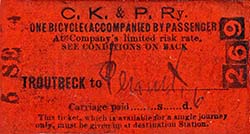 From January 1948 Troutbeck became part of British Railways (BR) London Midland Region (LM). The station, along with most of the others on the Workington – Penrith line, was fitted with BR(LM) maroon vitreous enamel nameboards and totem lamp tablets, probably in the late 1950s. Although the station had been gas-lit the lanterns in use by the late 1950s/early 1960s held oil lamps as the gas equipment had become life expired. From January 1948 Troutbeck became part of British Railways (BR) London Midland Region (LM). The station, along with most of the others on the Workington – Penrith line, was fitted with BR(LM) maroon vitreous enamel nameboards and totem lamp tablets, probably in the late 1950s. Although the station had been gas-lit the lanterns in use by the late 1950s/early 1960s held oil lamps as the gas equipment had become life expired.
The outer siding and coal drops at Troutbeck ceased to be used in 1955.
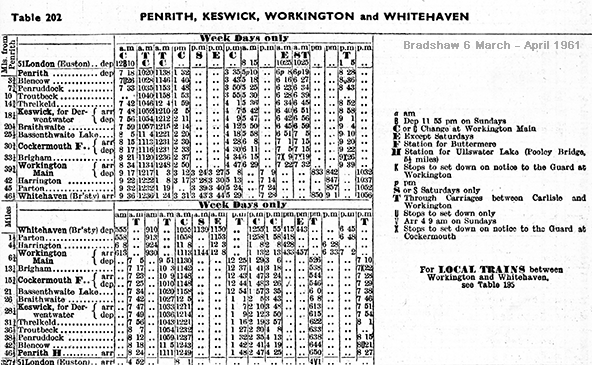
The former CK&P saw the introduction of diesel multiple units in January 1955 which gradually replaced steam-hauled passenger trains. In the summer 1956 timetable (below) Sunday trains commenced on the line, but Troutbeck was not served. On weekdays the earliest down and last up train did not call at Troutbeck.
Up trains: weekdays
11 Jun – 16 Sep 1956 |
Destination |
Down trains: weekdays |
Destination |
8.15am |
Carlisle |
10.38am |
Workington |
10.55am |
Carlisle ‡ |
12.01pm |
Workington |
12.39pm |
Penrith |
1.51pm |
Workington |
1.28pm |
Carlisle |
2.14pm SO § |
Workington |
2.30pm |
Penrith |
3.33pm SX |
Workington |
4.09pm |
Penrith |
3.58pm SO |
Workington |
6.34pm |
Carlisle |
5.28pm |
Workington |
- |
- |
6.41pm |
Workington † |
- |
= |
7.01pm # |
Workington |
No Sunday service
SX Saturday excepted SO Saturday only § 22 June to 1 September
# 9 July to 7 Sep SX; until 8 September SO ‡ Terminates at Penrith SO
† Continues to Whitehaven SO
Up trains: weekdays
14 June 1965 to 17 April 1966 |
Destination |
Down trains: weekdays |
Destination |
08.07 |
Carlisle |
09.53 |
Workington |
10.25 |
Carlisle |
11.57 |
Keswick |
12.58 |
Penrith |
13.55 |
Workington |
13.27 |
Carlisle |
17.20 |
Workington |
16.24 |
Carlisle ¶ |
18.30 |
Workington |
No Sunday service
¶ Terminates at Penrith Friday and Saturday 18 June to 4 September
In the 1965-66 timetable the last two up trains and the earliest and latest down trains did not call at Troutbeck. From May 1970 all trains called at this station.
 Whilst the Keswick to Workington section of the former CK&P closed to all traffic in April 1966 the Penrith-Keswick service continued for several years, but economies were made in operating the remaining branch. Goods had already ceased to be handled at Troutbeck on 1 June 1964, and in late 1966 the signal box closed. On 4 December 1967 the operation of the branch went over to ‘one engine in steam’ – effectively one long siding. The down track through the station was removed and the platform it had served was taken out of use. The waiting shelter (still furnished with a harmonium) remained in place for some years after the abandonment of this platform. Along with the other branch stations, Troutbeck was unstaffed from 1 July 1968. In the mid 1960s an electric lamp was installed at the western end of the building on the up platform, replacing oil lighting. Whilst the Keswick to Workington section of the former CK&P closed to all traffic in April 1966 the Penrith-Keswick service continued for several years, but economies were made in operating the remaining branch. Goods had already ceased to be handled at Troutbeck on 1 June 1964, and in late 1966 the signal box closed. On 4 December 1967 the operation of the branch went over to ‘one engine in steam’ – effectively one long siding. The down track through the station was removed and the platform it had served was taken out of use. The waiting shelter (still furnished with a harmonium) remained in place for some years after the abandonment of this platform. Along with the other branch stations, Troutbeck was unstaffed from 1 July 1968. In the mid 1960s an electric lamp was installed at the western end of the building on the up platform, replacing oil lighting.
Up trains: weekdays
3 May 1971 |
Destination |
Down trains: weekdays |
Destination |
07.59 |
Carlisle |
07.10 |
Keswick |
11.24 |
Penrith |
10.16 |
Keswick |
13.34 |
Penrith |
12.30 |
Keswick |
15.49 |
Penrith |
14.35 |
Keswick |
17.24 |
Penrith |
16.45 |
Keswick |
19.24 |
Carlisle |
18.45 |
Keswick |
No Sunday service
The timetable shown above would be the final one for Troutbeck as the Penrith-Keswick branch closed on 6 March 1972.
By April 1977 the waiting shelter on the down platform had been demolished, but the signal box, both platforms and the buildings on the up side were intact; the station building appeared derelict but the stationmaster’s house remained in occupation.
 Amongst several other abandoned railways, in his book A walk along the tracks (1982) Hunter Davies describes his recent exploration of the CK&P. He finds Troutbeck station house owned by a railwayman whose career started at Bassenthwaite Lake and who had the enviable task, immediately after closure in 1972, of visiting all of the CK&P stations and lineside buildings to identify the ‘redundant assets’ – in British Rail parlance – which could be saved or sent to be sold at BR’s Collectors’ Corner near Euston. Troutbeck station house was a redundant asset in which he was already living and he had been successful in buying it from BR Property Board in 1976. Davies also describes Troutbeck station’s signal box (‘the best I’d seen so far’) still complete with its levers, wires and rods. Amongst several other abandoned railways, in his book A walk along the tracks (1982) Hunter Davies describes his recent exploration of the CK&P. He finds Troutbeck station house owned by a railwayman whose career started at Bassenthwaite Lake and who had the enviable task, immediately after closure in 1972, of visiting all of the CK&P stations and lineside buildings to identify the ‘redundant assets’ – in British Rail parlance – which could be saved or sent to be sold at BR’s Collectors’ Corner near Euston. Troutbeck station house was a redundant asset in which he was already living and he had been successful in buying it from BR Property Board in 1976. Davies also describes Troutbeck station’s signal box (‘the best I’d seen so far’) still complete with its levers, wires and rods.
In 1984 the road overbridge west of the station was demolished since when the A5091 has crossed the former railway trackbed on the level. The stationmaster’s house remains in use in 2018 incorporating the former station building. The signal box and platforms have, unfortunately, been demolished.
Route map drawn by Alan Young. Bradshaw from Nick Catford. Totem from Richard Furness.
To see the other
stations on the Cockermouth - Penrith line click on the station name: Cockermouth 1st, Cockermouth 2nd, Embleton, Bassenthwaite Lake, Braithwaite, Keswick, Briery Siding Halt, Threlkeld, Highgate Platform, Penruddock & Blencow
Click here for a brief history of the Cockermouth, Keswick and Penrith Railway |

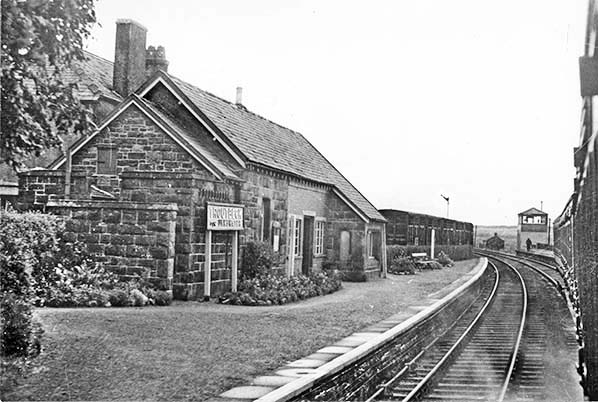

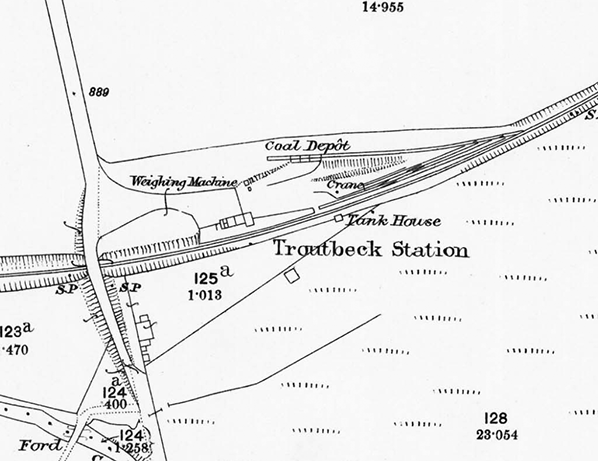
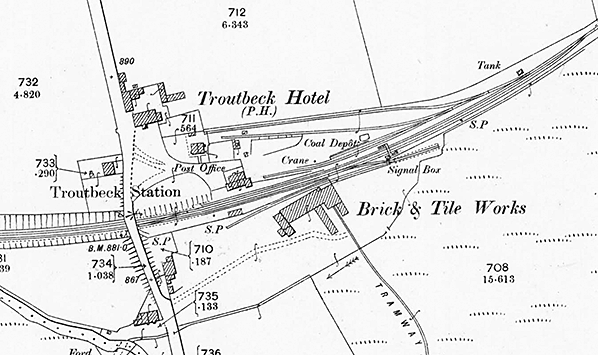
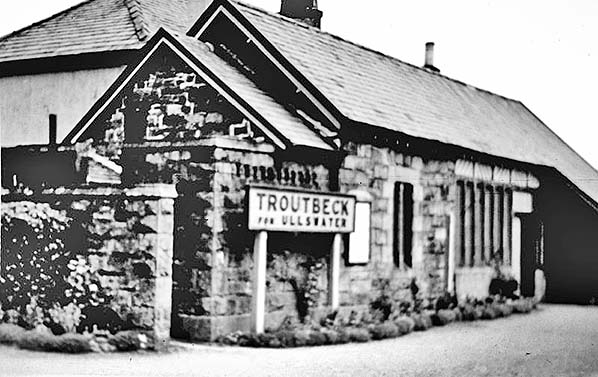
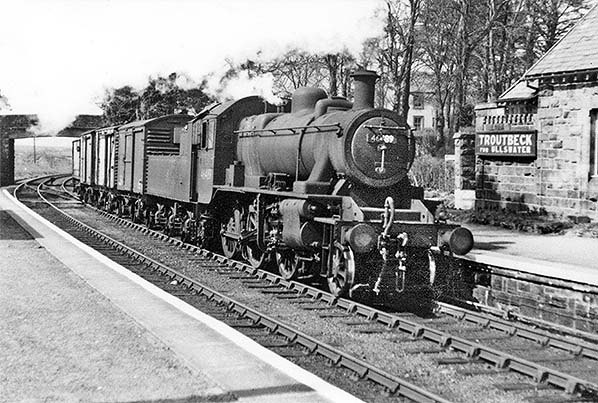

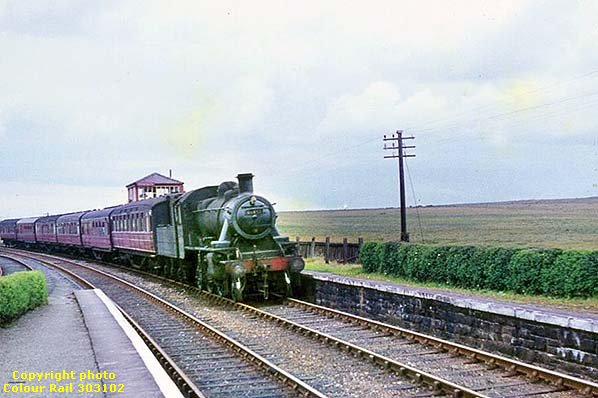
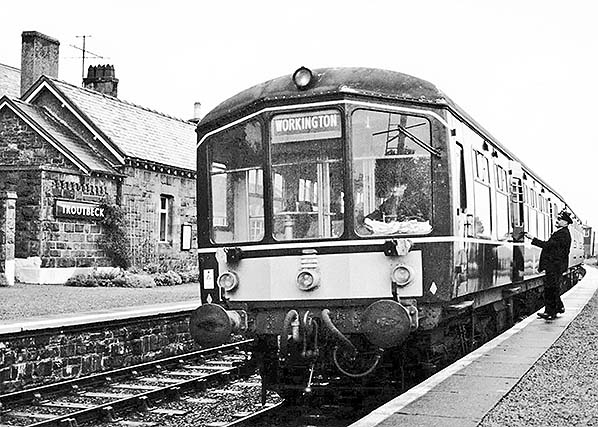
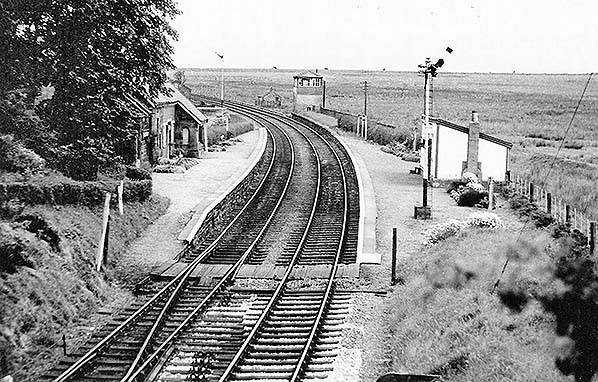


 As originally built the station had one platform on the north side of the single-track railway. The single-storey stone building was similar to that at Penruddock and some of the other minor stations on the route. It was provided with a pitched roof; however, at the eastern end the building stepped forward with a half-hipped gable facing east. This section contained the booking office, and its design allowed the stationmaster to have a good view of the platforms – for the same reason that some railway companies provided a bay window for the office. In addition to the office, a general room and a ladies’ waiting room were found in this building. At its western end was a short lower pitched roof and beyond it the gents’ urinal. In 1869 a stationmaster’s two-storey house was under construction, an austere hipped-roof edifice tucked into the rear of the station building; until it was completed the stationmaster lived in rented property.
As originally built the station had one platform on the north side of the single-track railway. The single-storey stone building was similar to that at Penruddock and some of the other minor stations on the route. It was provided with a pitched roof; however, at the eastern end the building stepped forward with a half-hipped gable facing east. This section contained the booking office, and its design allowed the stationmaster to have a good view of the platforms – for the same reason that some railway companies provided a bay window for the office. In addition to the office, a general room and a ladies’ waiting room were found in this building. At its western end was a short lower pitched roof and beyond it the gents’ urinal. In 1869 a stationmaster’s two-storey house was under construction, an austere hipped-roof edifice tucked into the rear of the station building; until it was completed the stationmaster lived in rented property.
 In November 1912 Mr Walton retired as stationmaster having given ‘long and faithful service’. His successor was J M Cutts, promoted from his post of Foreman Porter at Keswick. It was he who instituted the Sunday school and services in the station premises. During his time at Troutbeck, in January 1923 the station became part of the new London, Midland & Scottish Railway (LMS). He was replaced as stationmaster c1926 by Thompson Simpson who was to be the final holder of this post at Troutbeck; from 1932 the station came under the supervision of the Threlkeld stationmaster.
In November 1912 Mr Walton retired as stationmaster having given ‘long and faithful service’. His successor was J M Cutts, promoted from his post of Foreman Porter at Keswick. It was he who instituted the Sunday school and services in the station premises. During his time at Troutbeck, in January 1923 the station became part of the new London, Midland & Scottish Railway (LMS). He was replaced as stationmaster c1926 by Thompson Simpson who was to be the final holder of this post at Troutbeck; from 1932 the station came under the supervision of the Threlkeld stationmaster.  From January 1948 Troutbeck became part of British Railways (BR) London Midland Region (LM). The station, along with most of the others on the Workington – Penrith line, was fitted with BR(LM) maroon vitreous enamel nameboards and totem lamp tablets, probably in the late 1950s. Although the station had been gas-lit the lanterns in use by the late 1950s/early 1960s held oil lamps as the gas equipment had become life expired.
From January 1948 Troutbeck became part of British Railways (BR) London Midland Region (LM). The station, along with most of the others on the Workington – Penrith line, was fitted with BR(LM) maroon vitreous enamel nameboards and totem lamp tablets, probably in the late 1950s. Although the station had been gas-lit the lanterns in use by the late 1950s/early 1960s held oil lamps as the gas equipment had become life expired.
 Whilst the Keswick to Workington section of the former CK&P closed to all traffic in April 1966 the Penrith-Keswick service continued for several years, but economies were made in operating the remaining branch. Goods had already ceased to be handled at Troutbeck on 1 June 1964, and in late 1966 the signal box closed. On 4 December 1967 the operation of the branch went over to ‘one engine in steam’ – effectively one long siding. The down track through the station was removed and the platform it had served was taken out of use. The waiting shelter (still furnished with a harmonium) remained in place for some years after the abandonment of this platform. Along with the other branch stations, Troutbeck was unstaffed from 1 July 1968. In the mid 1960s an electric lamp was installed at the western end of the building on the up platform, replacing oil lighting.
Whilst the Keswick to Workington section of the former CK&P closed to all traffic in April 1966 the Penrith-Keswick service continued for several years, but economies were made in operating the remaining branch. Goods had already ceased to be handled at Troutbeck on 1 June 1964, and in late 1966 the signal box closed. On 4 December 1967 the operation of the branch went over to ‘one engine in steam’ – effectively one long siding. The down track through the station was removed and the platform it had served was taken out of use. The waiting shelter (still furnished with a harmonium) remained in place for some years after the abandonment of this platform. Along with the other branch stations, Troutbeck was unstaffed from 1 July 1968. In the mid 1960s an electric lamp was installed at the western end of the building on the up platform, replacing oil lighting. Amongst several other abandoned railways, in his book A walk along the tracks (1982) Hunter Davies describes his recent exploration of the CK&P. He finds Troutbeck station house owned by a railwayman whose career started at Bassenthwaite Lake and who had the enviable task, immediately after closure in 1972, of visiting all of the CK&P stations and lineside buildings to identify the ‘redundant assets’ – in British Rail parlance – which could be saved or sent to be sold at BR’s Collectors’ Corner near Euston. Troutbeck station house was a redundant asset in which he was already living and he had been successful in buying it from BR Property Board in 1976. Davies also describes Troutbeck station’s signal box (‘the best I’d seen so far’) still complete with its levers, wires and rods.
Amongst several other abandoned railways, in his book A walk along the tracks (1982) Hunter Davies describes his recent exploration of the CK&P. He finds Troutbeck station house owned by a railwayman whose career started at Bassenthwaite Lake and who had the enviable task, immediately after closure in 1972, of visiting all of the CK&P stations and lineside buildings to identify the ‘redundant assets’ – in British Rail parlance – which could be saved or sent to be sold at BR’s Collectors’ Corner near Euston. Troutbeck station house was a redundant asset in which he was already living and he had been successful in buying it from BR Property Board in 1976. Davies also describes Troutbeck station’s signal box (‘the best I’d seen so far’) still complete with its levers, wires and rods.
 Home Page
Home Page